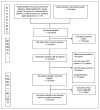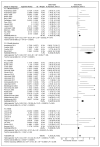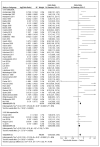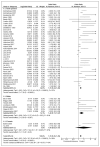Periodontal disease as a non-traditional risk factor for acute coronary syndrome: a systematic review and meta-analysis
- PMID: 36482952
- PMCID: PMC9715009
- DOI: 10.53854/liim-3004-4
Periodontal disease as a non-traditional risk factor for acute coronary syndrome: a systematic review and meta-analysis
Abstract
Objectives: Previous observational studies have suggested an association between periodontal disease (PD) and cardiovascular and cerebrovascular diseases. Nonetheless, evidence linking PD with coronary heart disease (CHD) and acute coronary syndrome (ACS) is still contradictory. We aim to systematically review the role of PD as a risk factor for ACS (myocardial infarction and unstable angina).
Methods: The protocol was registered in PROSPERO (CRD42021286278) and we followed the recommendations of the PRISMA and AMSTAR 2 guidelines. We systematically searched for 7 databases and electronic thesis repositories from inception to February 2022. We included articles without language restriction following the PECO strategy (population: "adult participants"; exposure: "periodontal disease"; comparator: "no periodontal disease"; outcome: "acute coronary syndrome" OR "acute myocardial infarction" OR "unstable angina"). Odds ratios (OR) with 95% confidence intervals (95% CI) were pooled using random effects and heterogeneity was quantified by Cochran's Q and Higgins' I2 statistics. Subgroup analyses were carried out according to the participants' sex, type of diagnosis of PD, type of study, and continent of origin of studies.
Results: We included 46 papers (17 cohort, 25 case-control, and 4 cross-sectional studies) that met the inclusion criteria. This meta-analysis includes a total of 6,806,286 participants and at least 68,932 ACS events, mainly myocardial infarction (MI). In accordance with our results, PD is associated with a higher risk of ACS (OR 1.35; 95% CI 1.25-1.45). However, clinical and methodological heterogeneity was significant (I2=86%, p<0.05). In the sensitivity analysis, the exclusion of some studies with "extreme" results (outliers) did not significantly affect the overall estimate or heterogeneity. In subgroup analysis, we found no statistically significant differences between men and women according to subgroup difference tests (I2=0%, p=0.67). Conversely, there were differences according to the type of diagnosis of PD (clinical or self-reported diagnosis), type of study (cohort, case-control, or cross-sectional study), and the continent of origin (North America, South America, Asia, or Europe) of the studies (I2=79%-96%, p<0.10). Of the 46 studies, only 4 had a high risk of bias. Additionally, the funnel plot suggested publication bias.
Conclusion: PD may be an important non-traditional risk factor for ACS. Although, this meta-analysis brings together more studies, and therefore more evidence, than any other previous similar study, its results should be interpreted with caution due to the great heterogeneity and the potential presence of bias.
Keywords: Periodontitis; acute coronary syndrome; myocardial infarction; periodontal diseases; systematic review.
Conflict of interest statement
Conflict of interest None to declare.
Figures






Similar articles
-
Further insights into to the role of statins against active tuberculosis: systematic review and meta-analysis.Infez Med. 2022 Jun 1;30(2):194-203. doi: 10.53854/liim-3002-4. eCollection 2022. Infez Med. 2022. PMID: 35693063 Free PMC article. Review.
-
The association between periodontal disease and the risk of myocardial infarction: a pooled analysis of observational studies.BMC Cardiovasc Disord. 2017 Feb 1;17(1):50. doi: 10.1186/s12872-017-0480-y. BMC Cardiovasc Disord. 2017. PMID: 28143450 Free PMC article. Review.
-
Periodontal disease and myocardial infarction risk: A meta-analysis of cohort studies.Am J Emerg Med. 2021 Oct;48:103-109. doi: 10.1016/j.ajem.2021.03.071. Epub 2021 Apr 8. Am J Emerg Med. 2021. PMID: 33866268 Review.
-
Circulating miRNA-21 as a diagnostic biomarker for acute coronary syndrome: a systematic review and meta-analysis of diagnostic test accuracy study.Cardiovasc Diagn Ther. 2024 Jun 30;14(3):328-339. doi: 10.21037/cdt-23-385. Epub 2024 Jun 11. Cardiovasc Diagn Ther. 2024. PMID: 38975002 Free PMC article.
-
Acute Coronary Syndrome, Stroke, and Mortality after Community-Acquired Pneumonia: Systematic Review and Meta-Analysis.J Clin Med. 2023 Mar 29;12(7):2577. doi: 10.3390/jcm12072577. J Clin Med. 2023. PMID: 37048661 Free PMC article. Review.
Cited by
-
The Role of the Oral Microbiome in the Development of Diseases.Int J Mol Sci. 2023 Mar 9;24(6):5231. doi: 10.3390/ijms24065231. Int J Mol Sci. 2023. PMID: 36982305 Free PMC article. Review.
-
2024 Guidelines of the Taiwan Society of Cardiology on the Primary Prevention of Atherosclerotic Cardiovascular Disease --- Part I.Acta Cardiol Sin. 2024 Sep;40(5):479-543. doi: 10.6515/ACS.202409_40(5).20240724A. Acta Cardiol Sin. 2024. PMID: 39308649 Free PMC article.
-
Periodontal disease and cardiovascular disease: umbrella review.BMC Oral Health. 2024 Oct 28;24(1):1308. doi: 10.1186/s12903-024-04907-1. BMC Oral Health. 2024. PMID: 39468505 Free PMC article.
-
Analysis of the Effects of IL-6 -572 C/G, CRP -757 A/G, and CRP -717 T/C Gene Polymorphisms; IL-6 Levels; and CRP Levels on Chronic Periodontitis in Coronary Artery Disease in Indonesia.Genes (Basel). 2023 May 12;14(5):1073. doi: 10.3390/genes14051073. Genes (Basel). 2023. PMID: 37239434 Free PMC article.
References
-
- Sánchez-Arias AG, Bobadilla-Serrano ME, Dimas-Altamirano B, et al. Enfermedad cardiovascular: primera causa de morbilidad en un hospital de tercer nivel. Rev Mex Cardiol. 2016;27(Suppl 3):98–102.
-
- Martínez-Pérez M, Almaguer-Mederos L, Medrano-Montero J, et al. Enfermedad periodontal y factores de riesgo aterotrombótico en pacientes con síndrome coronario agudo. CCM. 2020;24(4):1142–1159.
Publication types
LinkOut - more resources
Full Text Sources
Miscellaneous
